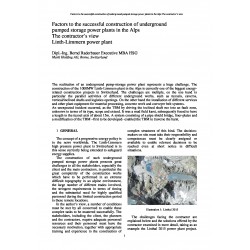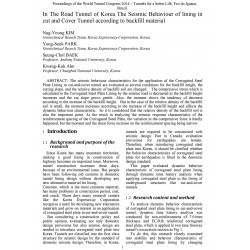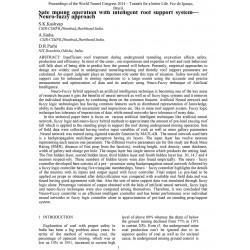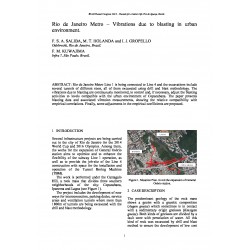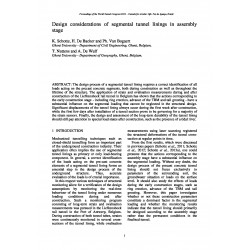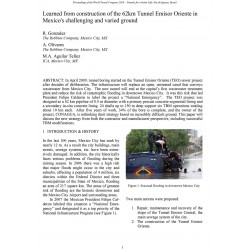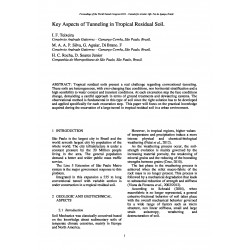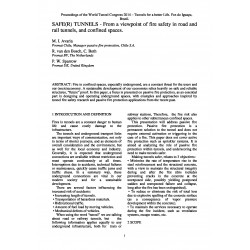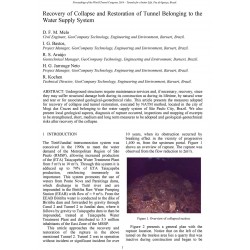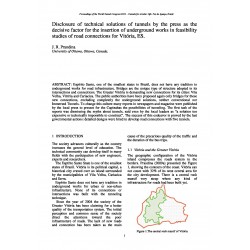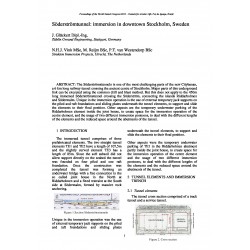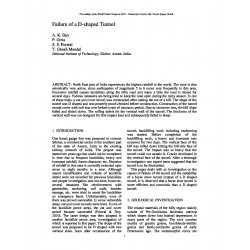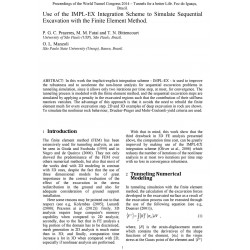No document
Search & filter
Search for a publication
Search & filter
World Tunnelling Congress
WTCThere are 1984 documents.
-
Factors to the successful construction of underground pumped storage power plants in the Alps The contractor’s view...
Abstract: The realization of an underground pump-storage power plant represents a huge challenge. The construction of the 1000MW Linth-Limmern plant in the Alps is currently one of the biggest energy- related construction projects in Switzerland. The challenges are multiple, on the one hand in particular the parallel activities of different underground works, such as tunnels, caverns, vertical/inclined...
0,00 € -
In The Road Tunnel of Korea The Seismic Behaviour of lining in cut and Cover Tunnel according to backfill material
Abstract: The seismic behaviour characteristics for the application of the Corrugated Steel Plate Lining in cut-and-cover tunnel are evaluated as several conditions for the backfill height, the cutting slope, and the relative density of backfill soil are changed. The compressive stress which is calculated in the Corrugated Steel Plate Lining by the seismic load is decreased as the backfill height...
0,00 € -
Safe mining operation with intelligent roof support system — Neuro-fuzzy approach
Abstract: Insufficient roof treatment during underground tunneling excavation affects safety, production and efficiency. In most of the cases , our experiences and expertise of soil and rock behaviour still falls short of being able to predict how the ground will behave. Presently, empirical approaches to design are widely used in underground tunneling/mining and thereby roof support parameters are...
0,00 € -
Rio de Janeiro Metro – Vibrations due to blasting in urban environment
Abstract: Rio de Janeiro Metro Line 1 is being connected to Line 4 and the excavations include several tunnels of different sizes, all of them excavated using drill and blast methodology. The vibrations due to blasting are continuously monitored, to control and, if necessary, adjust the blasting activities to levels compatible with the urban environment of Copacabana. The paper presents blasting data and...
0,00 € -
Design considerations of segmental tunnel linings in assembly stage
Abstract: The design process of a segmental tunnel lining requires a correct identification of all loads acting on the precast concrete segments, both during construction as well as throughout the lifetime of the structure. The application of strain and ovalisation measurements during and after construction of the Liefkenshoek rail tunnel in Belgium has shown that the actions corresponding to the early...
0,00 € -
Learned from construction of the 62km Tunnel Emisor Oriente in Mexico's challenging and varied ground
Abstract: In April 2009, tunnel boring started on the Tunnel Emisor Oriente (TEO) sewer project after decades of deliberation. The infrastructure will replace an open, untreated canal that conveys wastewater from Mexico City. The new tunnel will end at the capital’s first wastewater treatment plant and reduce the risk of catastrophic flooding in downtown Mexico City. It was this risk that led President...
0,00 € -
Key Aspects of Tunneling in Tropical Residual Soil
Abstract: Tropical residual soils present a real challenge regarding conventional tunneling. These soils are heterogeneous, with ever-changing face conditions, non horizontal stratification and a high sensibility to water content and transient conditions. At each excavation step the face conditions change, demanding a careful approach in terms of ground treatments and dewatering systems. The...
0,00 € -
Safe(r) Tunnels - From a viewpoint of fire safety in road and rail tunnels, and confined spaces
Abstract: Fire in confined spaces, especially underground, are a constant threat for the users and our (socio)economy. A sustainable development of our economies relies heavily on safe and reliable structures, “future” proof. In this paper, a focus is presented on passive fire protection, as an essential part in designing and operating underground spaces, with examples and approaches inspired by tunnel...
0,00 € -
Recovery of Collapse and Restoration of Tunnel Belonging to the Water Supply System
Abstract: Underground structures require maintenance services and, if necessary, recovery, since they may suffer structural damage both during its construction as during its lifetime, by natural wear and tear or for associated geological-geotechnical risks. This article presents the measures adopted for recovery of collapse and tunnel restoration, executed by NATM method, located in the city of Mogi das...
0,00 € -
Influence of composition parameters about characteristics tunnellining concrete subjected to high temperatures
Abstract: The objective of this experimental work is to investigate the fire performance of four concretes (named C1, C2, C3 and C4) made with different aggregates. C1 was made with land aggregates and C2, C3, C4 were made with dredged sediments. Physical and mechanical properties of all concretes were determined at temperatures of 20°C, 150°C, 350°C and 600°C. Results show that the concrete C3 has a...
0,00 € -
Disclosure of technical solutions of tunnels by the press as the decisive factor for the insertion of underground...
Abstract: Espírito Santo, one of the smallest states in Brazil, does not have any tradition in underground works for road infrastructure. Bridges are the unique type of structure adopted in its intersections and connections. The Greater Vitória is demanding new connections for its cities: Vila Velha, Vitória and Cariacica. The public authorities have been proposed again only bridges for these new...
0,00 € -
Söderströmtunnel: immersion in downtown Stockholm, Sweden
Abstract: The Söderströmstunneln is one of the most challenging parts of the new Citybanan, a 6 km long railway tunnel crossing the ancient centre of Stockholm. Major parts of this underground link can be executed using the common drill and blast method. But this does not apply to the 450m long immersed Söderströmstunnel crossing the Söderström, connecting the islands Riddarholmen and Södermalm. Unique...
0,00 € -
Analysis of the Influence of Metro Tunneling on Building Settlement
Abstract: Although the characteristics of ground settlement without buildings have been defined, but further research is still needed for the characteristics of settlement with buildings, and such research has more theoretical significance and engineering application value. Targeting at the specific strata and shallow foundation buildings, FLAC 3D is utilized to establish the three-dimensional numerical...
0,00 € -
Failure of a D-shaped Tunnel
Abstract: North East part of India experiences the highest rainfall in the world. The zone is also seismically very active, since earthquakes of magnitude 5 to 6 occur very frequently in this area. Excessive rainfall causes landslides along the hilly road and many a time the road is closed for several days. Various measures are being tried to keep the road open during the rainy season. In one of these...
0,00 € -
Analysis of Tunnels Using Latin Hypercube Sampling
Abstract: The paper is focused on the Latin Hypercube Sampling method (LHS) which can be successfully utilised for description of the variability of the soil and rock mass in the geotechnical design. It gives a brief description of the input parameters as random quantities and describes the LHS-mean method in detail with the focus on methods for statistical dependence. The main part of the paper is then...
0,00 € -
Use of the IMPL-EX Integration Scheme to Simulate Sequential Excavation with the Finite Element Method
Abstract: In this work the implicit-explicit integration scheme - IMPL-EX - is used to improve the robustness and to accelerate the non-linear analysis for sequential excavation problems in tunneling simulation, since it allows only two iterations per time step, at most, for convergence. The tunneling process is modeled with the finite element method, and the sequential excavation steps are simulated by...
0,00 €

